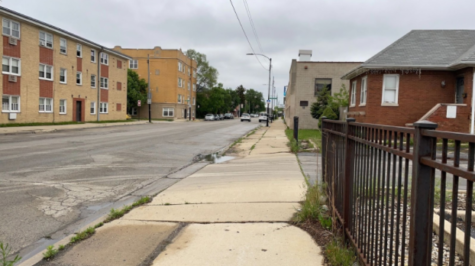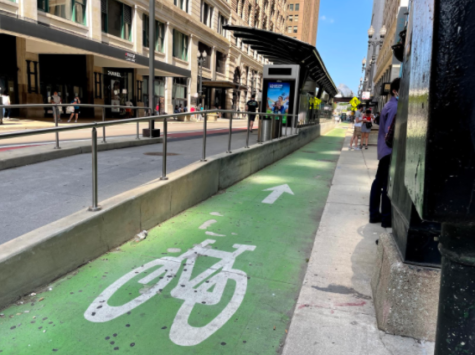Chicago Must Expand Its Network of Bicycle Infrastructure
June 15, 2021
In 2012, the Chicago Department of Transportation (CDOT) set out with a bold new plan to expand the city’s bicycle network. The Chicago Streets for Cycling Plan outlined goals for the city’s bicycle infrastructure by 2020. The plan set goals to bring the city to 645 miles of bike lanes, with 100 miles of protected bike lanes to be built by 2015. Today, the city only has 359 miles of lanes, and a dismal 28 miles are protected.
The city launched Divvy Bike in 2013 to increase and has since expanded Divvy access, yet the infrastructure has not allowed for it to be a safe and viable transportation option for most. In 2020, the city installed only 2.4 miles of barrier-protected bike lanes. New York City, meanwhile, added almost 30 miles of protected lanes in 2020, with another 30 miles planned for this year. The world has seen a surge in biking during the pandemic, but Chicago is letting this momentum slip away.
Cities from Beijing to Barcelona have realized how unsustainable cars are as a form of urban transportation. Cars are damaging to the natural environment both for their emissions and the sprawling development they encourage. Their insatiable need for space is impossible to provide in dense urban areas. While newer US cities have formed around freeways, older cities like Chicago have sacrificed most of its streetspace solely for the movement and storage of vehicles. Finally, cars have allowed for people to traverse entire cities without interacting with other people, something that goes against the social nature of cities.

Chicago must catch up by committing to creating a network of protected bicycle lanes across the city.
Bicycle infrastructure is an important investment for the city because it is an affordable way to increase urban mobility while benefiting the environment and public health.
In the Chicago region, an estimated 29% of greenhouse gas emissions come from transportation. A majority of these emissions come from private automobiles. Bicycles, though, emit no greenhouse gases after production. More people biking would mean cleaner air for residents. Additionally, the infrastructure needed to support a car-dependent transportation system has hurt the built environment. The need to accommodate cars in an urban
environment like Chicago leads to a sea of asphalt. Streets like Western or Kedzie Avenue have been hollowed out to allow for quick car travel, with wide lanes, parking lots and drive-thrus. Electric cars, too, will continue to encourage this style of development that makes streets places people have to be rather than want to be. By taking this space and giving it to other modes, like biking, the city can make streets more enjoyable and people-focused.
The increase in cyclists though proper infrastructure would also benefit public health. Car-dependence leads to citizens having more sedentary lifestyles. Commuting by bicycle greatly reduces the risk of diseases and encourages an active lifestyle. Health care costs are much lower for those who commute by bike rather than by car. The replacement of gas-guzzling SUVs with bicycles can also greatly improve air quality for all people on the street.
Bicycles can also help to fill a transit void in parts of the city where there is not much reliable CTA service. Chicago’s public transit is touted as an example for other US cities, but it is limited. While many rely on multiple transfers between bus and rail to get to a destination, the combination of a bike trip with a transit trip would make commutes quicker.
Finally, improvements to bicycle infrastructure are achievable because of their low cost and high impact on mobility. The creation of 100 miles of protected bike lanes would cost around $20 million. While this may seem like a lot, it is only a fraction the cost of improvements to infrastructure for cars. For example, the project to repair and expand the Jane Byrne Interchange would cost $756.5 million. This money could go far in building not just a few strips of protected bike lanes but an entire network that can continue to be expanded upon.
Biking is affordable not just for the city but also for individuals. A Divvi annual pass amounts to just nine dollars a month, while a CTA monthly pass costs $105. A network of bike lanes could increase mobility to Chicagoans with little money to spend on transportation.

The City of Chicago must commit to the expansion and maintenance of a bicycle network. The key to making bicycling a safe, reliable and convenient option is through the expansion of protected bicycle lanes—those physically separated from traffic. While the city can and should expand traditional lanes striped between parked cars and moving traffic, protected lanes are the main way for cities to substantially increase biking as a transportation mode. A Portland study cited in Chicago’s 2020 Streets for Cycling Plan said that 60% of residents are “interested but concerned” about biking in cities. For reference, less than 10% feel safe with traditional on-street lanes. This critical mass of the population will only adopt biking if there are widespread protected lanes across the city. Protected bike lanes, then, are a critical investment for the city’s transportation infrastructure.
The Chicago Department of Transportation should aim for Mayor Lightfoot’s campaign goal of 50 protected bike lanes before the end of her first term. The biggest struggle with building bike infrastructure is a lack of political will, so individuals should pressure the city to increase
Resources must also be set aside for the maintenance of these lanes. Those riding bikes in Chicago commonly complain that bike lanes are blocked by cars, snow or puddles. The city needs to set aside capital funding and staff specifically for bike lane maintenance and other street safety goals.
These efforts can be paid for through the city’s new 5-Year Capital Works Plan, a $3.7 billion dollar plan to improve the city’s infrastructure. A modest increase to the amount dedicated to biking improvements would allow for the city to start a network of protected bicycle lanes. The need to bring these safety and mobility improvements to the South and West sides and certain Aldermanic wards where these facilities aren’t present is necessary. Through this, the city can truly follow through with CDOT Commissioner Gia Biagi’s goal to goal to “prioritize making it easy to safely move around the city in sustainable ways.”
Chicago has fallen behind on creating a sustainable and equitable transportation system. Building out a network of bicycle infrastructure is a pedal in the right direction.

